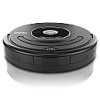iRobot Roomba 570 Service Manual - Page 43
Each TEST NUMBER has multiple SUB-TESTS. - user manual
 |
View all iRobot Roomba 570 manuals
Add to My Manuals
Save this manual to your list of manuals |
Page 43 highlights
o Power Roomba OFF by pressing the CLEAN button for a few seconds. o For AUTO-ADVANCE mode hold down the CLEAN and DOCK buttons and press the SPOT button 3 times. Release buttons. o For MANUAL-ADVANCE mode: hold down the CLEAN and DOCK buttons and press the SPOT button 6 times. Release buttons. o Wait for the Built-in-Test sound. Note : o To get out of BIT once in it, hold down DOCK and SPOT for 10 seconds. o To advance a step press DOCK and to go back a step press SPOT. BUILT-IN-TEST 0 tests the user panel LEDs. o For base robot assembly 3.5 check that a. DIRT ALERT flashes at beginning b. SPOT and DOCK are toggling c. SCHEDULE and CLOCK are toggling d. CHECK ROBOT is on e. The clock display is toggling through the 7 segments including the semi colon : f. AM and PM are toggling o For base robot assembly 3.3 and 3.4 check that : a. SPOT and DOCK are toggling b. CHECK ROBOT is on Note : Even in AUTO-ADVANCE mode, you must advance to Test 1 by pressing the DOCK button. In the BUILT-IN-TEST (all test numbers except 0): 1. Each TEST NUMBER has multiple SUB-TESTS. o The SPOT, CLEAN and DIAGNOSTIC LEDs indicate when the sensors are activated. o Current measurements are taken in 0.5 second readings. During current readings, ALL LEDS ARE OFF. o The DIRT ALERT LED will blink to indicate that the test is advancing to the next test number. During a test, the DIRT ALERT will indicate the step number by a pattern of long and short blinks where one long flash is equal to five short blinks. For example, test 12 is indicated by long-long-short-short. o The robot will BEEP when advancing to the next Built in Test number. Test numbers are indicated by a pattern of long and short beeps, where one long beep is equal to five short beeps. For example, test 11 is indicated by long-long-short. 43















